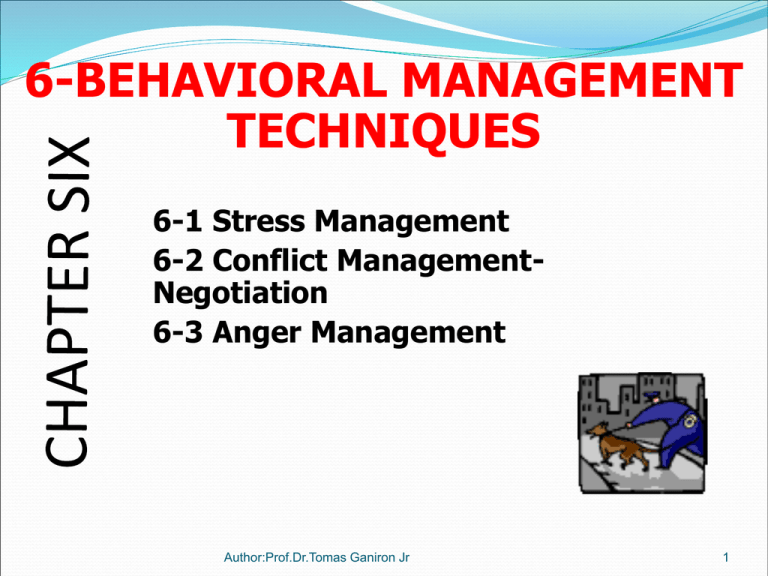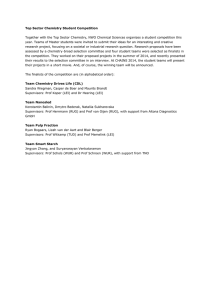
6-BEHAVIORAL MANAGEMENT
TECHNIQUES
6-1 Stress Management
6-2 Conflict ManagementNegotiation
6-3 Anger Management
Author:Prof.Dr.Tomas Ganiron Jr
1
6-1 Stress Management
Author:Prof.Dr.Tomas Ganiron Jr
2
WHAT IS STRESS?
• It is your mind and body’s response or
reaction to a real or imagined threat, event
or change.
* The threat, event or change are commonly
called stressors. Stressors can be internal
(thoughts, beliefs, attitudes or external (loss,
tragedy, change).
Author:Prof.Dr.Tomas Ganiron Jr
3
1.
EUSTRESS
2.
DISTRESS
Author:Prof.Dr.Tomas Ganiron Jr
4
1. EUSTRESS
This is caused by happy and exciting events in our
lives such as Child birth, graduation, promotion,
going abroad and weddings.
This stress is positive, progressive, normal,
necessary, tolerable and manageable.
Author:Prof.Dr.Tomas Ganiron Jr
5
2. DISTRESS
This is caused by sad and unexpected events in our
lives such as death, ill-health, divorce and loss of a
job
This stress is negative, abnormal, regressive, and
disturbing.
This is the stress that needs to be managed.
Author:Prof.Dr.Tomas Ganiron Jr
6
BURNOUT
It is the lethargic feeling that comes in when
someone’s energy is depleted, at which time they
no longer feel like doing anything.
It is not only about the work place. It is about life
issues too. People lose enthusiasm and become
pessimistic. They view everything as an
impossibility and they no longer have the vigour
to go on
Author:Prof.Dr.Tomas Ganiron Jr
7
ALARM STAGE
* As you begin to experience a stressful event
or perceive something to be stressful
psychological changes occur in your body.
* This experience or perception disrupts
your body’s normal balance and
immediately your body begins to respond to
the stressor(s) as effectively as possible.
Author:Prof.Dr.Tomas Ganiron Jr
8
SYMPTOMS OF ALARM STAGE
*
*
*
*
Cardiac - increased heart rate
Respiratory - increased respiration
Skin - decreased temperature
Hormonal - increased stimulation of
adrenal genes which produce an
adrenal rush.
Author:Prof.Dr.Tomas Ganiron Jr
9
RESISTANCE STAGE
During this stage your body tries to cope or
adapt to the stressors by beginning a process
of repairing any damage the stressor has
caused. Your friends, family or co-workers
may notice changes in you before you do so
it is important to examine their feedback to
make sure you do not reach overload.
Author:Prof.Dr.Tomas Ganiron Jr
10
SYMPTOMS OF RESISTANCE STAGE
* Behavior indicators include lack of
enthusiasm for family, school, work or life in
general, withdrawal, change in eating habits,
insomnia, hypersomnia, anger, fatigue.
* Cognitive indicators include- poor
problem solving, confusion, nightmares,
hyper-vigilance.
Author:Prof.Dr.Tomas Ganiron Jr
11
EXHAUSTION STAGE
During this stage the stressor is not being
managed effectively and the body and mind
are not able to repair the damage.
Author:Prof.Dr.Tomas Ganiron Jr
12
EXAMPLES OF EXHAUSTION STAGE
Digestive disorders, withdrawal, headaches,
tension, insomnia, loss of temper.
Author:Prof.Dr.Tomas Ganiron Jr
13
SOURCES OF STRESS IN AN
ORGANIZATION
Tight deadlines
Work load/less work load
Frequent transfers
Long working hours
Repetitive nature of work
Low job satisfaction
Author:Prof.Dr.Tomas Ganiron Jr
14
SOURCES OF STRESS IN AN
ORGANIZATION cont-- Field work
Cultural diversity
Obsession with work
Inadequate resources
Lack of proper communication
Different expectations
Weather conditions
Author:Prof.Dr.Tomas Ganiron Jr
15
SYMPTOMS OF STRESS
PHYSICAL SIGNS
Overeating/eating too little
Tension/headaches
Fatigue
Muscle aches
Substance abuse
Indigestion
Author:Prof.Dr.Tomas Ganiron Jr
16
SYMPTOMS OF STRESS
EMOTIONAL SIGNS
Anxiety
Frustration
Mood swings
Bad Temper
Nervousness
Crying spells
Lack of self esteem & confidence
Author:Prof.Dr.Tomas Ganiron Jr
17
SYMPTOMS OF STRESS
MEDICAL SIGNS
Ulcers
High blood pressure
Insomnia
Loss of libido (interest in sex)
Fainting
Colds, flu, bronchial asthma & other infections
Author:Prof.Dr.Tomas Ganiron Jr
18
Stress Management
This is all about taking charge: taking charge of your
thoughts, your emotions, your schedule, your
environment, and the way you deal with problems.
The ultimate goal is a balanced life, with time for work,
relationships, relaxation, and fun – plus the resilience
to hold up under pressure and meet challenges head
on.
Author:Prof.Dr.Tomas Ganiron Jr
19
PROPER STRESS COPING
MECHANISMS
1. Become Self Aware
One way of doing this is understanding your self
concept. This helps one to accept situations and look
for realistic solutions knowing that life needs to go
on.
This means that one will be able to orient rapidly to
change & accept to get help from external sources
Author:Prof.Dr.Tomas Ganiron Jr
20
PROPER STRESS COPING
MECHANISMS cont---
2. Develop and Maintain a positive Attitude
Psychology says that we have the ability within us to
choose our feelings and attitudes irrespective of the
situation we are going through
Author:Prof.Dr.Tomas Ganiron Jr
21
PROPER STRESS COPING MECHANISMS
cont--4. Develop Hobbies
Don’t just sit there staring into space. Get up and
swim, walk, watch a play, dance, join the choir or do
community work.
5. Manage your Time
Make time for yourself and make your priorities
right.
Empower your juniors by delegating without
abdicating
Author:Prof.Dr.Tomas Ganiron Jr
22
PROPER STRESS COPING MECHANISMS
cont--6. Understand your environment
It is your responsibility to know your operating
environment. What is your boss like? What does
he/she like? Who are the decision makers?
Appreciate that your boss also has his/her own
stress.
Author:Prof.Dr.Tomas Ganiron Jr
23
PROPER STRESS COPING
MECHANISMS cont--7. Be Proactive
Stephen R. Covey (1989) in his book, ‘The 7 habits
of effective people’ states that reactive people are
affected by the weather but proactive people carry
their weather with them. Whether it rains or shines
makes no difference to them. They are value driven.
Author:Prof.Dr.Tomas Ganiron Jr
24
PROPER STRESS COPING MECHANISMS
cont--8. Eat Well
Three square meal a day!! Proper nutrition is
important. A good breakfast is a must if you are to
stop craving for unhealthy snacks at 10 o’clock.
Avoid processed foods and unnecessary sugar
intake.
Author:Prof.Dr.Tomas Ganiron Jr
25
PROPER STRESS COPING MECHANISMS
cont--9. Nurture your Love life
The sacrifices each one in the relationship makes
with both partners respecting their individuality and
developing one another become cushions in times of
trouble.
Stable emotions boost one’s whole being
Author:Prof.Dr.Tomas Ganiron Jr
26
PROPER STRESS COPING
MECHANISMS cont--10. Keep good grooming
This uplifts one’s self esteem and restores the lost
self image which is destroyed by stress.
11. Exercise regularly
Author:Prof.Dr.Tomas Ganiron Jr
27
SUGGESTED RELAXATION ACTIVITIES
TO REDUCE STRESS
Deep breathing: This can be done even as one is
seated on the office chair
Going for a walk: Gives one a chance to ‘smell the
flowers’
Take up a sport: Keeps your body active and takes
up your idle time
Meditation: Religious or other forms: Away to seek
peace.
Author:Prof.Dr.Tomas Ganiron Jr
28
SUGGESTED RELAXATION ACTIVITIES
TO REDUCE STRESS
A picnic out with the family: Enjoy different
surroundings from usual
Vigorous Dancing: Good exercise to release
negative energy
Gardening: Gives you a chance for outdoor
activities
Learning to speak a new Language: Improves
your self esteem
Author:Prof.Dr.Tomas Ganiron Jr
29
Author:Prof.Dr.Tomas Ganiron Jr
30
Definition of Conflict
A condition that exists anytime two or more
people disagree
Is a form of competition between perceived or
actual incompatible needs, goals, desires, ideas,
or resources(collectively called interests the
“desired state”).
A natural phenomenon, neither inherently good
or bad, but there may be positive or negative
outcomes.
Author:Prof.Dr.Tomas Ganiron Jr
31
Causes of conflict
Conflict of aims- different goals
Conflict of ideas- different interpretations
Conflict of attitudes - different opinions
Conflict of behavior- different behaviors are
unacceptable
Author:Prof.Dr.Tomas Ganiron Jr
32
Conflict Management
It involves implementing strategies to limit the
negative aspects of conflict and to increase the positive
aspects of conflict at a level equal to or higher than
where the conflict is taking place.
To enhance learning and group outcomes and not
concerned with eliminating all conflict or avoiding
conflict.
Author:Prof.Dr.Tomas Ganiron Jr
33
Conflict Management
In situations of crisis and potential conflict always remember star
STAR
We need to:
STOP
THINK
ANALYSE
RESPOND
Author:Prof.Dr.Tomas Ganiron Jr
34
Conflict Resolution Strategies
AVOIDANCE
FORCE
ACCOMMODATE
COMPROMISE
COLLABORATE
Author:Prof.Dr.Tomas Ganiron Jr
Wait/See
Win/Lose
Lose/Win
Lose/Win
Win/Win
35
Conflict Management
Strategies
Author:Prof.Dr.Tomas Ganiron Jr
36
Conflict Continuum
I win, you lose (competition—A)
I lose or give in (accommodate—B)
We both get something
(compromise—C)
We both “win”(collaborate—D)
A
B
C
D
37
1. Force (Competition)
This is a type of conflict management strategy by using
formal authority or other power that you possess to satisfy
your concerns without regard to the concerns of the party
that you are in conflict with.
Author:Prof.Dr.Tomas Ganiron Jr
38
1. Force (Competition)
Plus
The winner is clear
Winners usually experience gains
Minus
Establishes the battleground for the next conflict
May cause worthy competitors to withdraw or leave the
organization
39
2. Accommodate
This is a type of conflict management strategy by
allowing the other party to satisfy their concerns
while neglecting your own.
Author:Prof.Dr.Tomas Ganiron Jr
40
2. Accommodation
Plus
Curtails conflict situation
Enhances ego of the other
Minus
Sometimes establishes a precedence
Does not fully engage participants
41
3. Avoidance
This is a type of conflict management strategy by not
paying attention to the conflict and not taking any
action to resolve it.
Author:Prof.Dr.Tomas Ganiron Jr
42
4. Compromise
This is a type of conflict management strategy by
attempting to resolve a conflict through identifying a
solution that is partially satisfactory to both parties,
but completely satisfactory to neither.
Author:Prof.Dr.Tomas Ganiron Jr
43
4. Compromise
Plus
Shows good will
Establishes friendship
Minus
No one gets what they want
May feel like a dead end
44
5. Collaborate
This is a type of conflict management strategy cooperating
with the other party to understand their concerns and
expressing your own concerns in an effort to find a mutually
and completely satisfactory solution (win-win).
Author:Prof.Dr.Tomas Ganiron Jr
45
5. Collaboration
Plus
Everyone “wins”
Creates good feelings
Minus
Hard to achieve since no one knows how
Often confusing since players can “win” something they
didn’t know they wanted
46
Tips for Managing Workplace
Conflict
Build good relationships before conflict occurs
Do not let small problems escalate; deal with them as they
47
arise
Respect differences
Listen to others’ perspectives on the conflict situation
Acknowledge feelings before focussing on facts
Focus on solving problems, not changing people
If you can’t resolve the problem, turn to someone who can
help
Remember to adapt your style to the situation and persons
involved
WHAT IS NEGOTIATION ?
The word "negotiation" originated from the Latin
expression, "negotiatus", which means "to carry on
business".
The process of conferring to arrive at an agreement
between different parties, each with their own interests
and preferences.
“A give-and-take decision-making process involving
interdependent parties with different preferences.”
48
Why do we NEGOTIATE ?
To reach an agreement
To beat the opposition
To compromise
To settle an argument
To make a point
49
TYPES OF NEGOTIATION
Distributive Negotiation
Integrative Negotiation
50
st
1
Type: Distributive Negotiation
Parties compete over the distribution of a fixed sum of
value. The key question in a distributed negotiation is,
“Who will claim the most value?” A gain by one side is
made at the expanse of other.
The Seller’s goal is to negotiate as high a price as possible;
the Buyer’s goal is to negotiate as low a price as possible.
Thus, the deal is confined: there are not much
opportunities for creativity or for enlarging the scope of
the negotiation.
51
2nd Type: Integrative Negotiation
In
Integrative Negotiation, parties cooperate to achieve
maximize benefits by integrating their interests into an
agreement. This is also known as a win-win negotiation.
* The key questions is: “How can the resource best be utilized?”
Integrative negotiations tend to occur in following situations:
– Structuring of complex long-term Strategic Relationships or
other collaborations.
– When the deal involves many financial and non-financial
terms.
In an integrative negotiation,, there are many items and issues to
be negotiated, and the goal of each side is to “create” as much
value as possible for itself and the other side.
52
BATNA
BATNA is an acronym for:
Best
Alternative
To
a
Negotiated
Agreement
53
Why BATNAs Matter
BATNAs tell you when to accept and when to reject an
agreement
When a proposal is better than your BATNA: ACCEPT
IT
When a proposal is worse than your BATNA: REJECT
IT
54
BATNA
“Best Alternative to a Negotiated Agreement”
Develop “your” BATNA
- List your alternatives
- Evaluate your alternatives
- Establish your best as your BATNA
Consider “their” BATNA
Have a Reservation Point – the least you will accept
List their alternatives – their BATNA
55
Example:
[Showroom salesman
V/s customers]
BATNA Example
A persons go for car
purchase.
[To negotiate with showroom sales man for
lesser price]
The car owner is not
agreeing for the lesser
price.
Than customer can ask for
Radial tires[best alternative]
with any increase in price
further.
56
NEGOTIATION TIPS
1) Do not underestimate your power.
2) Do not assume that other party knows
your weaknesses.
3) It is a mistake to assume you know what
the other party wants.
4) Never accept the 1st offer.
5) Don’t fear to negotiate.
57
SKILLS FOR EFFECTIVE NEGOTIATION
Preparation and planning skill
Knowledge of the subject
Ability to think clearly and rapidly
under pressure and uncertainty
Ability to express thoughts verbally
Listening skill
Patience
General problem-solving and
analytical skills
58
6-3 Anger Management
Author:Prof.Dr.Tomas Ganiron Jr
59
What is Anger?
Anger is "an emotional state that varies in
intensity from mild irritation to intense fury and rage."
- Charles Spielberger, PhD
Author:Prof.Dr.Tomas Ganiron Jr
60
Anger is:
a result of our thinking
a choice
controlled by your own
thinking
Author:Prof.Dr.Tomas Ganiron Jr
Anger is not:
a reflex
automatic
caused by others
61
SYMPTOMS OF ANGER EXPRESSION
1. PASSIVE ANGER
2. AGGRESSIVE ANGER
Author:Prof.Dr.Tomas Ganiron Jr
62
1. PASSIVE ANGER
Dispassion-such as giving the cold shoulder or phony
smiles, looking unconcerned, sitting on the fence while
others sort things out, dampening feelings with
substance abuse, overeating,
and oversleeping.
Author:Prof.Dr.Tomas Ganiron Jr
63
1. PASSIVE ANGER
Evasiveness- such as turning your back in a crisis,
avoiding conflict, not arguing back, becoming phobic.
Ineffectualness- such as setting yourself and others
up for failure, choosing unreliable people to depend
on, being accident prone, underachieving, sexual
impotence, expressing frustration at insignificant
things but ignoring serious ones.
Author:Prof.Dr.Tomas Ganiron Jr
64
1. PASSIVE ANGER
Obsessive Behavior-such as needing to be
inordinately clean and tidy, making a habit of
constantly checking things, over-dieting or overeating,
demanding that all jobs be done perfectly.
Author:Prof.Dr.Tomas Ganiron Jr
65
1. PASSIVE ANGER
Psychological Manipulation- such as, sabotaging
relationships, using sexual provocation, using a third
party to convey negative feelings, withholding money
or resources
Author:Prof.Dr.Tomas Ganiron Jr
66
1. PASSIVE ANGER
Secretive Behavior -such as giving the silent
treatment or under the breath mutterings, avoiding
eye contact, putting people down, anonymous
complaints, poison pen letters and stealing.
Author:Prof.Dr.Tomas Ganiron Jr
67
1. PASSIVE ANGER
Self Blame-, such as apologizing too often, being
overly critical, inviting criticism.
Self sacrifice-such as being overly helpful, making do
with second best, quietly making long suffering signs
but refusing help, or lapping up gratefulness
Author:Prof.Dr.Tomas Ganiron Jr
68
2. AGGRESSIVE ANGER
Bullying- such as threatening people directly,
persecuting, pushing or shoving, using power to
oppress, shouting, driving someone off the road,
playing on people‘s weaknesses.
Destructiveness, such as destroying objects, harming
animals, destroying a relationship, reckless driving,
substance abuse,
Author:Prof.Dr.Tomas Ganiron Jr
69
2. AGGRESSIVE ANGER
Grandiosity- such as showing off, expressing
mistrust, not delegating, being a sore loser, wanting
center stage all the time, not listening, talking over
people's heads, expecting kiss and make-up sessions to
solve problems.
Author:Prof.Dr.Tomas Ganiron Jr
70
2. AGGRESSIVE ANGER
Hurtfulness- such as physical violence, including
sexual abuse and rape, verbal abuse, biased or vulgar
jokes, breaking a confidence, using foul language,
ignoring people’s feelings, discriminating d, blaming,
punishing people for unwarranted deeds, labeling
others.
Author:Prof.Dr.Tomas Ganiron Jr
71
2. AGGRESSIVE ANGER
Manic behavior- such as speaking too fast, walking
too fast, working too much and expecting others to fit
in, driving too fast, reckless spending.
Selfishness-such as ignoring others' needs, not
responding to requests for help.
Author:Prof.Dr.Tomas Ganiron Jr
72
2. AGGRESSIVE ANGER
Threats, such as frightening people by saying how you
could harm them, finger pointing, excessively blowing
a car horn, slamming doors.
Unjust Blaming-such as accusing other people for
your own mistakes, blaming people for your own
feelings, making general accusations.
Author:Prof.Dr.Tomas Ganiron Jr
73
2. AGGRESSIVE ANGER
Unpredictability-such as explosive rages over minor
frustrations, attacking indiscriminately, inflicting
harm on others for the sake of it, using alcohol and
drugs and illogical arguments.
Vengeance- such asrefusing to forgive and forget,
bringing up hurtful memories from the past.
Author:Prof.Dr.Tomas Ganiron Jr
74
Feelings of Power
Self-Righteous
Get people’s attention
Make them do what you want
Author:Prof.Dr.Tomas Ganiron Jr
75
These are examples of Common factors that can make
people angry:
•Losing someone you love
•Sexual frustration
•Being tired, hungry or pain
•Physical withdrawal from certain medicines
or drugs
Author:Prof.Dr.Tomas Ganiron Jr
76
Anger Management
It refers to a system of psychological techniques and
exercises by which someone with excessive or
uncontrollable anger& aggression can control or
reduce the triggers, degrees, and effects of an angered
emotional state.
Author:Prof.Dr.Tomas Ganiron Jr
77
The Assertive Problem Solving Style of anger management
can be summed up using the ACTS technique.
ACTS
A = AWARE of your anger signals
C = CONTROL your response
T = TALK about the situation in a calm, polite, and
assertive manner
S = SOLVE the problem through a mutually agreeable
plan of action
Author:Prof.Dr.Tomas Ganiron Jr
78
CAN ANGER BE A POSITIVE?
Although anger is often viewed as a negative feeling, it
can be used in a positive way…
Anger provides cues that there is a problem
Anger provides energy and can help motivate action
Anger encourages the expression of feelings
Author:Prof.Dr.Tomas Ganiron Jr
79
WAYS TO EASE FEELINGS OF ANGER
Take a walk or engage in some other physical activity
Perform a relaxation exercise (e.g. meditation,
progressive relaxation, etc.)
Read a book
Listen to music
Watch television
Talk to or call a friend
Write in your journal
Complete chores
Author:Prof.Dr.Tomas Ganiron Jr
80
Practicing Relaxation
Progressive relaxation
Take 3 deep abdominal breaths and imagine the tension
leaving your body as you exhale
Clench your fists and hold for up to 10 seconds (use this
amount of time for each muscle group). Release.
Tighten your biceps. Release.
Tighten your triceps. Release.
Continue to follow the directions above for each muscle
group making sure you include muscles in your face,
shoulders, and core, and continue to breathe deeply.
Author:Prof.Dr.Tomas Ganiron Jr
81
• Exercise
• Music (Diaphragmatic breathing)
• Classical or sound of nature
• Praying (Salah)
• Warm Bath
• Massage
Author:Prof.Dr.Tomas Ganiron Jr
82
•Identify a range of feelings including anger
•Identify aggressive acts by self and others
•Identify self-destructive behavior
•Identify thoughts prior to aggressive acts
•Identify internal cues to feelings of anger
Author:Prof.Dr.Tomas Ganiron Jr
83
Anger can be your friend or enemy;
it depends on the way in which
you choose to express it.
Author:Prof.Dr.Tomas Ganiron Jr
84
Anger is a natural part of life. It has many causes and there
are many ways to deal with anger.
When anger has a connection with spirituality, it is
important to acknowledge it and try to understand where the
anger is coming from.
Often, it is best to go through this process with a trusted
professional, such as a therapist or appropriately trained
spiritual leader.
Author:Prof.Dr.Tomas Ganiron Jr
85





